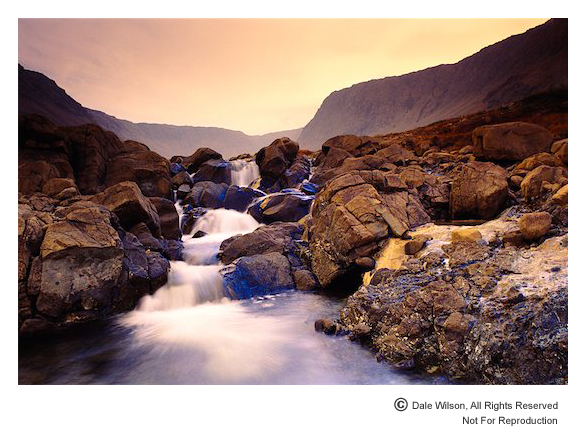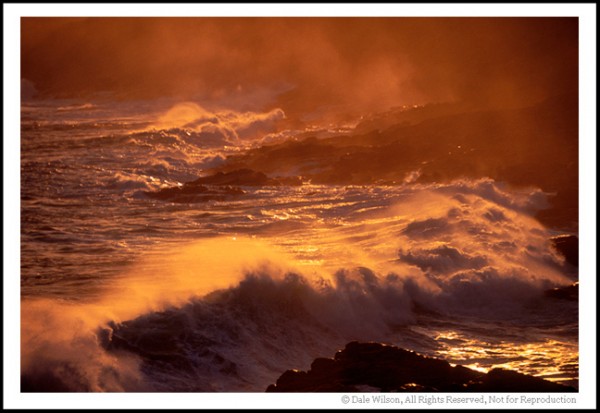Gros Morne National Park is to Atlantic Canada what Banff is to Alberta: a treasure trove of photographic opportunities. One major difference between the two National Parks is that Gros Morne receives only about 120,000 visitors per year, while Banff gets four million.

Gros Morne Mountain as seen from Rocky Harbour Pond. Filters used: Cokin 173 Blue/Yellow Colour Polarizing, Cokin 2-stop blue soft edge graduated and Singh-Ray Colour Intensifying
Designated a UNESCO World Heritage Site, Gros Morne is best photographed by concentrating on a given topic or subject matter, be it wildlife, flora, seascapes or landscapes. Each geographical region in the park offers its own rewards and anyone planning to explore and photograph Eastern Canada’s premium photo destination should schedule a minimum of four days.
While each month offers its own special attractions and challenges, I prefer to photograph Gros Morne in September when the air is usually clear of atmospheric haze and there are few tourists. Late in September many of the animals –moose in particular—become more active as they enter the rutting season. July is prone to a lot of atmospheric haze and August is the warmest month, averaging around 20 degrees Celsius and rarely going above 25 degrees.
Even during the summer months snow can be found at higher elevations in the cirques and shadows zones of north facing mountains, and evening can be quite cool. In addition to foul-weather gear, warm clothing and wind breakers are a must for personal comfort. Even during the summer months finger-less are invaluable for handling the cold legs of a tripod and providing some shelter against chilly winds.
Access is gained by driving along route 430 (the Viking Trail) from Deer Lake to the park’s epicentre at Rocky Harbour, about 71 kilometres. Or, turn off route 430 onto route 431 at Wiltondale to access the south side of the park, where you will drive past the Tablelands mountains and eventually arrive at the fishing hamlet of Trout River.
Often overlooked, the Tablelands mountain range is one of the most unusual geological formations in the world. The yellowish-brown rock known as peridotite was thrown heavenward by the continual bump-and-grind of plate tectonics. Exposed from the earth’s mantle, this rock is devoid of plant supporting nutrients, and consequently the Tablelands Range hosts only a few varieties of flora, with most to be found along the banks of Winterhouse Brook.

Winterhouse Brook in the Tablelands. Filters used: Cokin 173 Blue/Yellow Colour Polarizing and Cokin 2-stop grey soft edge graduated
Photographically, the Tablelands is a challenge that demands the photographer’s full attention to make creative images. The light is unique due to the topography; both morning and evening is in shadow and light only makes its way into this valley during high noon. However, if you must make a choice, opt for evening when you can drive along route 431 and view the mountain range to the south. On those few occasions when the evening light bathes this unique landscape the colour of the rocks will be sublime and unparalleled in eastern Canada.
One of the most exciting areas to photograph seascapes is the north side of Bonne Bay, just a few kilometres past Lobster Cove Head lighthouse. Green Point, on the Gulf of St. Lawrence, provides an ideal vantage point as the large rocks turn a lovely shade of orange in the sweet light of sunrise and sunset – and you can photograph both from this location. The best access is via a single lane gravel driveway on your left about 500 metres beyond the Green Point Campground. You will recognize the spot when you find fishermen’s seasonal cabins along the shoreline. As this is a working area for the fisherfolk, it is courteous to park at the top of the bank and walk over the hill to the shoreline. There are no tips with respect to how best create images from this location, simply walk along the shoreline and change lenses as your creative vision dictates.

Green Point at dusk in pending storm light. Filters used: Cokin 173 Blue/Yellow Colour Polarizing, Singh Ray Colour Intensifying and Cokin 2-stop grey soft edge graduated
Other attractions not to be missed in Gros Morne National Park are Western Brook Pond and the boat tour of this land-locked fiord. Secure your reservations at least a day in advance from the tour office located in the Ocean View Hotel in Rocky Harbour. As awe-inspiring as this trip down the fiord is, it is incredibly difficult to capture creative images as you are restricted by the movement of the boat and the lack of light reaching the 675 metre high south wall. Given the choice, opt for the last run of the day for best light.
As mentioned above, bring warm clothes, sturdy footwear, lots of media cards and allow at least four days and you will be rewarded with the most exciting, photographic diversity and easily accessable region in Atlantic Canada.
Post originally from: Digital Photography Tips.
Check out our more Photography Tips at Photography Tips for Beginners, Portrait Photography Tips and Wedding Photography Tips.
Canadian Travelogue -Newfoundland- Gros Morne National Park













You must be logged in to post a comment.